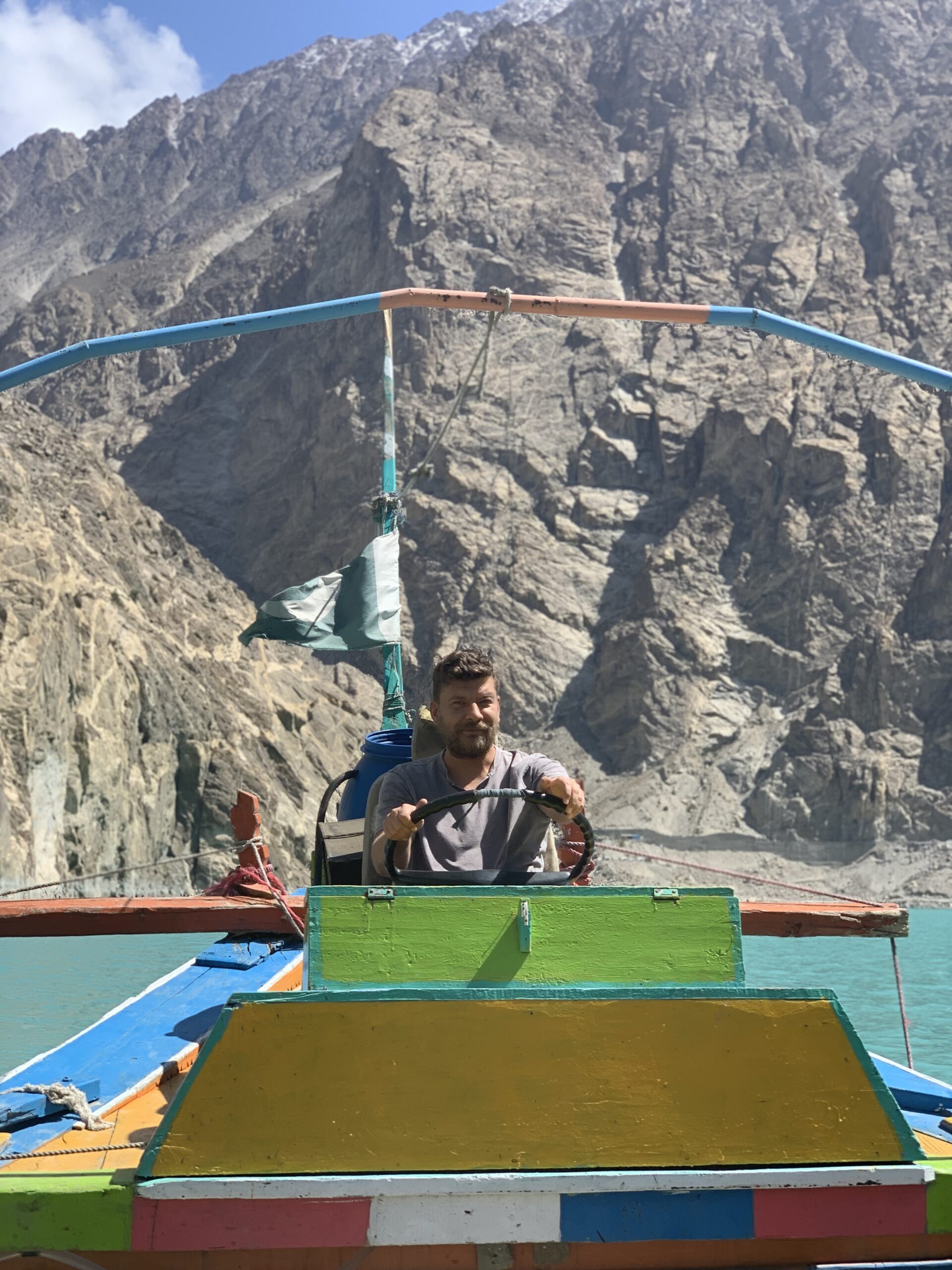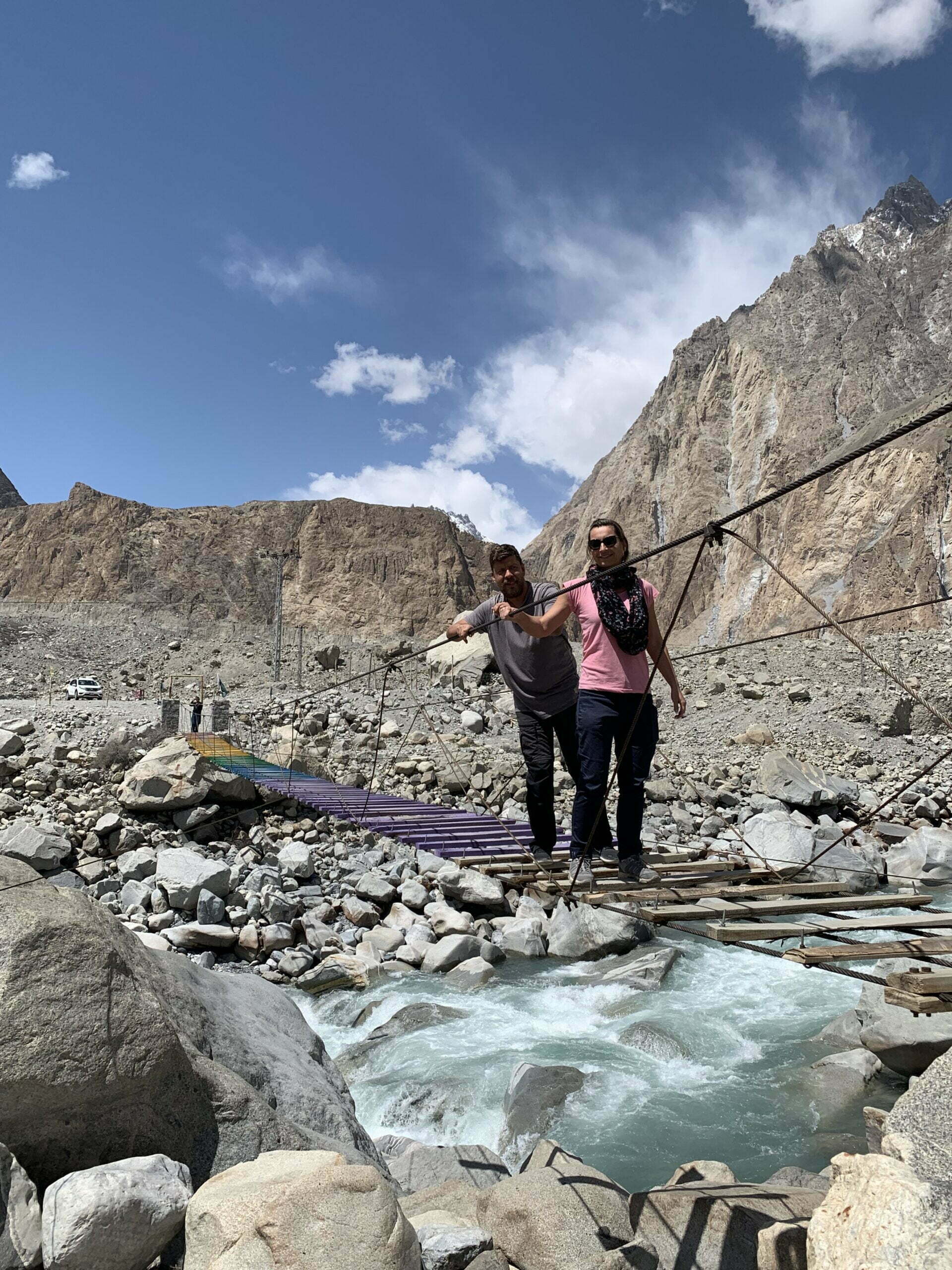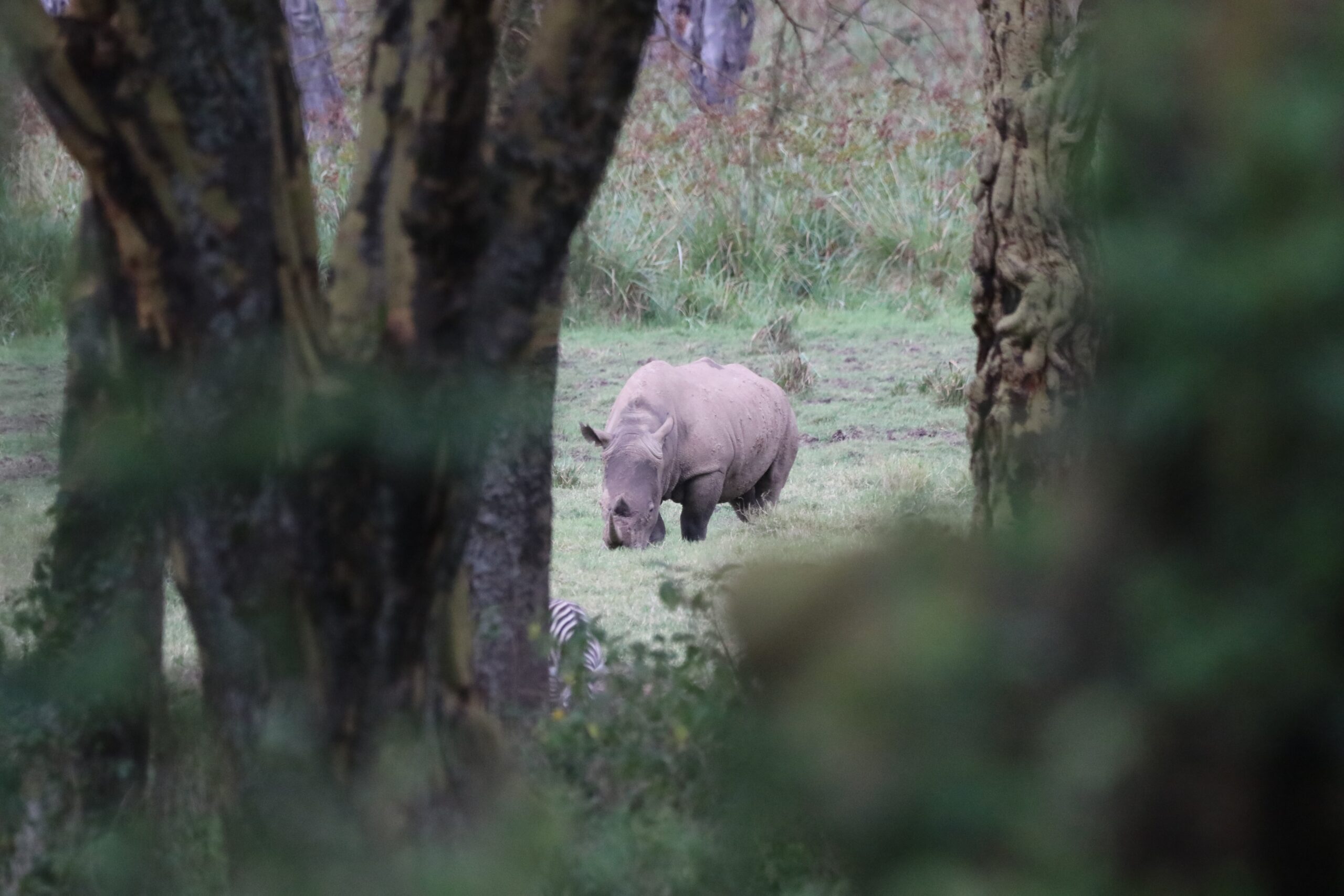What we just remembered about yesterday’s conversation with the shopkeeper: it was also interesting to learn that there is a crime rate of almost 0% in the Hunza Valley, and since the locals eat a lot of apricots, vegetables and the mineral-rich, almost milky white water, the life expectancy is almost 100 years. But that is only in addition.
Our alarm clock rang early in the morning at 04 o’clock – Ahmad had moved our visit to the Eagle’s Nest – a viewpoint over the entire valley – to today’s sunrise the day before. So we all got into our white vehicle, drowsy and just barely awake on time. We spent 2 hours at the viewpoint and marveled at the spectacle before we drove back to the hotel at about 06:30.
Since Melanie had a slight stomach ache, Andreas went to breakfast alone before he also went to bed for a short while. And of course we all overslept a little bit our actually planned departure date. So we set off about half an hour later than planned to our next destination of the day, Lake Attabad.
On the way to said lake, we again passed through countless tunnels, which had been kindly built here by the Chinese. A part of these tunnels was still quite fresh, partly built in 2010-2015, after the Attabad Lake had been artificially created by a landslide in 2010. Already in 2008 cracks had appeared in the mountain, which then led to the catastrophic landslide in January 2010, in which several people died, several villages were flooded by the damming of the Hunza River and the Karakoram Highway was also flooded on a length of 25km.
But people are people and so in the course of time a recreational area with hotel facilities and many water sports, such as jet skiing and boat tours, developed on and around the lake. And so it happened that we also landed on a somewhat historic fishing boat, which Andreas was allowed to steer temporarily across the lake.




After we dropped anchor again, we met a group of Hungarian photographers before we continued our journey. The Hungarians let their drone take off despite an absolute ban and so Andreas quickly found a topic of conversation. Apparently, the tour operator had obtained special permission for the flight over several months. It was also interesting to learn that it was not safety concerns that spoke against the launch, but simply the fact that many drone pilots had already accidentally sunk their expensive toys in the lake.
On the way to our next destination we stopped at a street café so that Melanie could refresh her coffee reserves and Mudassir – despite Ramadan – could “secretly” smoke again. The coffee shop at the famous Hussaini suspension bridge turned out to be a mini museum with inscribed stones and banknotes with greeting messages, which people from all over the world had left here in memory. The operator had even received an official certificate from the Pakistani government, which distinguished him as a “keeper of memories” and which he proudly presented to us.
But we still had a long way to go and due to the morning delay unfortunately not the time to go immediately to the suspension bridge. Instead, we visited a smaller one, which was directly on the roadside – even this small suspension bridge was enough “excitement” for Melanie. After crossing the bridge and taking a few photos, we continued on our way until we finally reached the village of Sost.


In this place we changed from our vehicle into a 4×4 jeep, which should bring us the remaining, almost 100km (2 hours) over the snowy pass roads to the Chinese border. The driver of the 4×4 was a cool guy, about 25 years old, with a lot of fluff and loose sayings in his head, named Hanif. Somehow the chemistry between us was right from the start.
Together we drove now to 5 further and quite soon we reached the border to the Khunjerab Nature Park. While Hanif had to show documents, we were taken out of the car, because not far from us already before the nature park ibexes were to be seen. This made our hope grow to see some animals today. After we had seen our fill, our journey continued. Already 10 minutes later, we were at the next post house and again we were taken out of the car. A scout showed us through his huge telescope a herd of about 30 ibexes, felt several kilometers away, in the middle of the steep slope. After the bystanders caught sight of Andrea’s camera, a short conversation developed. One of the men organized tours to find and photograph snow leopards, which were also native here. Before moving on, there was a bit of storytelling and pictures of snow leopards and big cats from Africa were shared and admired.
The pass road meandered higher and higher, the gray of the mountains gave way more and more to a white of the snow, which was still everywhere. In places Hanif had to drive around some past rockfalls and so we reached the Chinese border after just under 100km and about 2 hours.
Arrived at just under 4700m, Andreas in particular was surprised about the yet pleasant temperature (but we were also once more lucky, because the sun shone against us all) and marveled – much to the amazement of some locals present – the whole scenery dressed only in a T-shirt. Unfortunately, the here erected, world-highest, ATM was closed and the moreover we were allowed to approach the border gate only up to about 900m. The whole thing was justified with the fear of the Chinese of Corona – the border was closed.




While Andreas was still busy with his camera, Melanie was already surrounded by several men who were quite wild about photos with her. While Andreas approached this scene, the discussions there became more and more heated. The group of men was 100% sure that Andreas was a world famous actor. Melanie tried to convince the group of the opposite, but she was not believed and so the next legend was born and hundreds more group and individual photos were shot.
After the men had left the border in their 2 vehicles, a Pakistani border guard joined us. He had observed the whole thing from a distance and now also wanted a few photos with the “legend”. We gladly complied with this request – in return we got a special permit from him and he escorted us up to about 500 meters to the Chinese border gate. Soon, however, we had to make our way back and the soldier asked us to be taken down into the valley.




On the way back, we learned that the border guards were only here in summer. He described the winter at 4700 meters altitude as a “death zone” with icy winds and temperatures around minus 45 degrees Celsius. Also interesting was a short anecdote according to which soldiers and material had been flown in by helicopter for the construction of the border installations. After we arrived back at the boarding point of the 4×4 jeep (a small roadside café), we met some of Hanif’s family. Especially his sweet nieces, who at the age of 4 already spoke 5 languages (Urdu, English, Chinese and 2 local dialects).
On the way back to Karimabad we saw the Passu Cones and – after Melanie had insisted – stopped at the Hussaini Suspension Bridge. The bridge was 193m long in total, we went about halfway and took some more photos.
Back in Karimabad, the locals had lit hundreds, or thousands of lights all along the roadside. Upon inquiry, we learned that this was a local tradition and that no one knew exactly what purpose this whole spectacle was supposed to serve. For dinner, Ahmad took us to a small wooden hut of a super nice local cook, who prepared all the dishes fresh, organic and without additives in her small kitchen before our eyes (absolute recommendation). While we enjoyed the food, we chatted a bit with her and at the end she even invited us for green tea.







Jahrgang 1981;
Technikfreak und Hobby-Fotograf (inkl. Videos)





Recent Comments